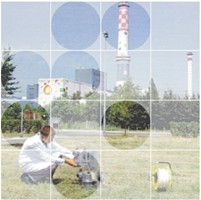
The present-day concern for the environment that is much in evidence in the work of the Institute is grounded in its original purpose of providing scientific back-up for the young nuclear power industry. As early as the fifties, special attention was being paid to developing analytical methods for characterizing nuclear materials, but this rapidly expanded to take in the determination of metals, radioactive elements and organic substances in a wide range of ecological samples. The multi-disciplinary nature of the Institute, coupled with close collaboration between departments, has provided the basis for the development and application of more precise and sensitive analytical tools, making use of the expertise and instrumentation which support the basic research programmes. The structure of the Institute, as conceived by the first Director, Anton Peterlin, has, in this way, proved ideal for the evolution of environmental monitoring.
The Institute's concern today is not limited to passive assessment of the environment, but is devoted to its protection and improvement. In keeping with this aim, the Department for Environmental Impact Assessment was established in 1974 on the initiative of the Jožef Stefan Institute. A multidisciplinary group of leading experts from this and other Slovene institutes and faculties cooperate in evaluating the environmental impact of a wide variety of investigative projects and, through their recommendations, aim to prevent or minimize any harmful effects of the anticipated environmental impact. About 700 projects have so far been evaluated, including a calcite mine, a polyurethane plant and a military training ground.
|
Evolvement of research areas
ENVIRONMENT
More recently, the Institute initiated a multidisciplinary approach to studies of pollution, as the best approach to protecting the environment. Bio-indicators, including lichens, moss, fungi, roe deer and the ubiquitous Slovenian bee, are in use as long-term monitors of air pollution. In particular, levels of toxic heavy metals, specific organic pollutants and radionuclides in the form of electrofilter ash and contaminated air particulates are regularly monitored, the heavy metals being part of a European Project.
An important contribution to environmental safety in the early days was made by the inorganic chemists who developed the semi-industrial plant, with closed water circulation, for uranium ore reprocessing at the uranium mine at Žirovski vrh.
A great deal of effort has been devoted over the years to the environmental impact of fossil-fuel combustion and the treatment of gaseous and liquid waste from industry. The Institute has, in bilateral co-operation with international companies, developed the technology of desulphurisation of waste gases from thermal power plants.
Leakage of radon gas from the ground can lead to significant levels of radioactivity in enclosed buildings. In order to obtain reliable estimates of long-term human exposure, levels of radon and its decay products are being determined in Slovenian schools and homes. Other radiological survey programmes include those for the Krško Nuclear Power Plant and for the former uranium mine at Žirovski vrh. The latter led to harmful effects on the environment around the uranium mine being minimised.
Water is another important resource and special attention is paid to monitoring the quality of underground water for human consumption. The impact of mercury draining from the large mining area of Idria and of PCBs in the river Krupa region are examples of major applied water projects with important implications for the environment.
The Institute also provides ecological monitoring services to the farming, food and pharmaceutical industries. Thus, toxic contaminants, essential elements and organic compounds have been analysed in food, soil and sewage sludge.
All this analytical and monitoring work in both nuclear and non-nuclear areas has been based on the use of standard instrumentation such as gas chromatography and mass spectrometry, as well as on the development and application of highly specialised techniques including neutron activation analysis and cold vapour atomic absorption spectrometry. Many of these are used in nuclear physics and have the advantage that many trace elements can be analysed at the same time with a high degree of accuracy. The X-ray fluorescence and proton induced X-ray methods, for example, were introduced at the beginning of the eighties, making use of the Van de Graaff accelerator. Currently, a new tandem accelerator TANDETRON is used for this type of analysis.
The blue and yellow vehicles of the Mobile Unit of the Ecological Laboratory are a common sight in Slovenia. This Unit was established in 1982 within the UNDP project. Its prime aims are to detect and assess accidental pollution of the environment by radioactive, chemical and biological pollutants and to provide recommendations, based on expert appraisal, to those authorities responsible for implementing protective measures. This Unit is multidisciplinary in its character and forms part of a co-operative project between several laboratories of the Institute and other institutes in Slovenia.
The Institute provides a training ground for many young scientists who, besides working on basic science problems, may also become involved in applied research projects and technological developments. One such successful applied project was the development of an automated meteorological station for the nuclear power plant in Krsko. This station was later upgraded, in co-operation with the Slovenian Hydro-Meteorological Establishment, to a computer based station for automated measurement of gases and radioactivity in the air together with other important meteorological parameters. It forms part of the Slovene ecological information network.
|
